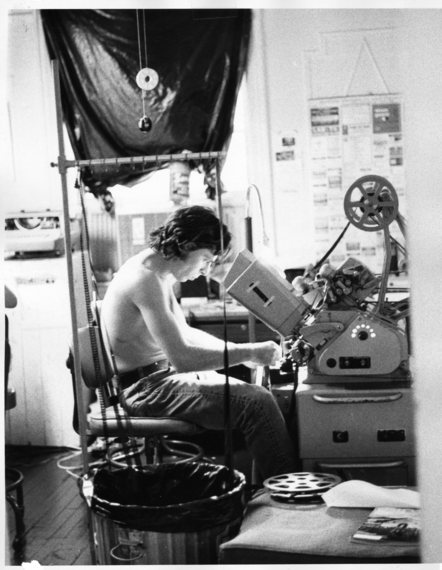Once upon a time there was a film school at NYU called simply The Institute of Film and Television, not to be confused today with a more high falutin' Maurice Kanbar Institute of Film and Television. Maurice Kanbar, it seems, contributed pot full's of dough he accumulated selling Skyy Vodka and wanted his name in lights, so to speak.
I spent two years in the place, 1970-1971...
Flashback: The ninth floor in NYU's East Building, home of the film school. The corridors are abuzz with activity. Dressed down longhairs of both sexes wander through the halls clutching film textbooks with evocative titles like The Grammar of Film and The Filmmakers Art. A stocky young guy comes walking past dressed in a worn fatigue jacket clutching a 16mm film can, holding it close like it contained the crown jewels. I catch his glance and nod. Scrawled in Sharpie black on the side of the can is a title, Far From Vietnam. He's in one of my classes and seems to be perpetually dogged by a depressing dark cloud. Someone mentioned he just returned from Vietnam.
There's a large room off to one side divided up with a bunch of work areas, small cubbyholes. I feel a frantic energy emitted and spy the source: a young teaching instructor with unkempt greasy long dark hair. He's slamming hard on the clutch of a 16mm monolith of a Moviola editing machine, whack-a-mole style, orchestrating a bunch of cut points. Fundamentals of Filmmaking is what he teaches and it's the introductory course we've all taken upon our arrival as neophyte filmmakers.
For me, NYU Film School was a bit of a lark. It was two-year program at the time. Prior to transferring I'd been screwing around with liberal arts in NYU's Washington Square College getting involved in the usual stoner pastimes of tasting as many recreational drugs as possible. Pot was king - everything from wacky weed and Thai sticks to opiated hash - and they were consumed through a variety of jerry-rigged methods including old World War II gas masks which you could pick up for a song at the Army Navy stores that dotted Canal Street. Then there were the various hallucinogens, peyote buttons, acid and the notorious MDA (a three day trip). There were also failed moronic attempts to get high by smoking toasted up banana peels (not). But I did find some like-minded students who shared anarchist inclinations and we grouped together as Transcendental Students, devoted to pushing a culturally liberating philosophy mainly by "liberating" spaces at NYU like the student cafeteria, bringing in a rock band and distributing copious amounts of jug wine and pot; all of which didn't go down to well with the administration (they would routinely call in the NYPD to clear the place). But the fun of filming the events with an old third-hand wind-up Bolex convinced me that my career path was padded with celluloid and decided to switch over to the Film School where I figured I could exercise my political prerogatives, learn film and maybe get a degree.
Yes, it was everything I wanted... and more.
NYU Film School was the idea of one Haig Manoogian, an avuncular strongly opinionated Armenian-American who loved movies and had taken the subject from an English department afterthought to a commandeered space on the 9th floor of East Building, establishing a curriculum of its own. Within a few years he had found a kindred spirit: an equally spirited young student by the name of Martin Scorsese (the aforementioned teaching instructor at the controls of the Moviola). After graduation he was elevated to teaching instructor, charged with teaching us beginners the glorious history of the movie and the rudiments of how to put one together.
The filmmaking process back then was all circa 19th century with film gear having more in common with a machine shop engine lathe than with a computer motherboard; essentially industrial age technology. There was nothing ergonomic about the boxy 16mm cameras you had to lug around while tethered by cable to a sound recording device held by a fellow student. It was hard grueling work and you took to the streets in a kind of pas de deux, gingerly watching your steps making sure not to turn sync cords into trip wires. A good "vérité" camera person had to be part gymnast, part ballerina and when you'd just want to settle the camera down on a tripod - so called "sticks" - it required either one weight lifter or two normal assistants: one to field the actual wooden legs (no carbon fiber here), the other to wrestle with a heavy fluid filled tripod head that allegedly smoothed out pans and tilts but more often than not "skipped" a bit during a planned supple move. Editing equipment was all about gears, belts, and enough friction devices to make a mechanical engineer beam with pride and were called with monikers like moviescopes, sound boxes, synchronizers, split reels and Rivas splicers and there's probably any number of my contemporaries who could recall requisite disasters like when split reels came apart sending hundreds of feet of film flying or the endless hair-pulling when trying to stick a small plastic core that decided to "drop" from the middle of 1000 foot flat of reversal film.
In those heady early days NYU Film School was fraught with drama: students trying to edge out one another to suck up to any and all visiting Hollywood directors or dodging and positioning for first dibs at the newest technology and by "new" I mean simply a more highly evolved set of gears, belts and friction devices. I almost made it to NYU's first so-called "flatbed" Moviola - where film and tape laid horizontal instead of upright - only to be aced out by a quicker moving female student (who went on to a successful Hollywood career) who grabbed the seat while I was still in the throes of worshipful adoration. But the 'Agitata da due Venti' inside paled by comparison to the global earthquake going on in the streets below. "Our cameras have gun sights" was Jean Luc Godard's call to arms and a mantra we recited as we took to the streets to record ground breaking revolutionary events at 24 frames per second.
There was still plenty of time for free love, sex and fun -- it was like Emma Goldman said, "If I can't dance, I don't want to be part of your revolution," -- and fueled by weed we did occasionally enjoy goofing on our film school compatriots like when TS spread rumors about an impending raid to confiscate all bourgeois student films deemed devoid of revolutionary content. Standing back a fair distance in a corridor we watched as a mad rush of students tripped over one another in an effort to spirit away metal film cans to safer climes.
There was real danger when we took our cameras to the often violent anti-war demonstrations where very obvious police undercover agents were shooting photos of the participants and one day we heard that two of the better known representatives of the NYPD's so-called Red Squad had paid a visit to NYU and peppered poor Haig Manoogian with questions about what really was being taught on the 9th floor. Later, after successfully obtaining our police files, we discovered that the distraught Haig had huddled with protege Scorsese and decided to simply tell the surveillance "flics" that our school project had something to do with "constitutional rights."
Scorsese, in fact, ended up taking our first NYU student film, Inciting to Riot, which chronicled the activities of TS to the prestigious Festival Dei Popoli where it won some sort of recognition (can't recall what) but it did garner a grand prize at the NSA film Festival (National Student Association not it's surveillance counterpart).
FLASH FORWARD: Martin Scorsese addresses the assembled student body at the NYU Film School at commencement, May, 2014. As I watch him reference the early days, waxing poetic about his mentor Haig Manoogian, I know there's an inspirational quote coming and it does and it's a Teddy Roosevelt doozy:
It's not the critic who counts ... It is the man who actually strives to do the deeds, who knows the great enthusiasm and knows the great devotion, who spends himself on a worthy cause, who at best, knows in the end the triumph of great achievement. And, who at worst, if he fails, at least fails while daring greatly, so that his place shall never be with those cold and cruel souls who know neither victory nor defeat.
Scorsese provides back end punctuation with trademarked staccato hand gestures and pronounced movements of both eyebrows and the crowd loves it. Unfortunately, as these departing kids will soon find out, critics do count and if they didn't you wouldn't have a huge industry employing high-powered film publicists who make sure that the right critics are brought around to review any upcoming Hollywood film.
Is this new generation of students any different from the graduating class of my day? No, according Nick Tanis, a former film school compatriot who never left the place and has been teaching full-time since 1973, "We're still the same place: crazed energetic students reaching for the stars, but now there are 1200 of them rather than 250."
I feel sorry for every single one of them knowing that odds for Scorsese-like success rival that of a long-term Israeli-Palestinian peace settlement. But hey, there may be a Vince Gilligan or two among them.
Waxing nostalgic makes me want to get my hands on an old upright Moviola. It's a magical machine that captures a bygone age of cinema, a tactile one where you held images in your hand and then fed the delivery system, celluloid, through metal sprockets, rubber belts and optics. Maybe I'll ask Oliver Stone - my fellow film student (the one pursued by the dark cloud) - where he got his. Lately I noticed he positions a primo specimen in the background while he sits for formal interviews.
Joel Sucher, a filmmaker with Pacific Street Films, is a writer and contributing blogger for Huffington Post. He's also written on the foreclosure crisis for American Banker and In These Times and is currently considering whether to write a book or produce a film about NYU Film School.

